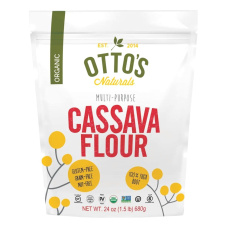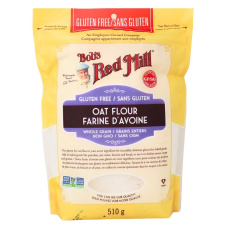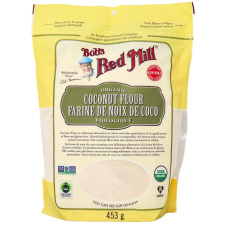
Flour 101: Types of Flour, Their Health Benefits & How to Use Each
With so many types of flour, it can be overwhelming to decide which one to use. From almond flour to coconut flour to all-purpose flour, each of these flours is scientifically designed to play a specific role in recipes. So, using the wrong type of flour could cost you hours of work and the integrity or flavour of the delicious product you were after. And, like many, you may have specific dietary needs or allergies, giving you another thing to worry about. But, worry not, we’ll break it all down for you. Keep reading to learn more about the types of flour, their health benefits and expert insights on how to best use each flour.
What Are The Types of Flour?
Flour is one of the oldest ingredients in our arsenal, so you can bet that there’s a long list of flour options available. And, everyday the list just keeps getting longer with new additions like keto flour, paleo flour and gluten-free flour blends. In this article, we’ll touch upon almond flour, cassava flour, coconut flour, tigernut flour, oat flour, rice flour, amaranth flour and all-purpose flour. After reading this article you’ll be a next level expert on flour and will be able to decide which flour best suits your dietary needs.
What is Almond Flour?
Almond flour simply refers to flour made from grounded almonds. The almonds are blanched, grinded, then sifted into a fine flour-like powder. Almond flour is common in premium pastries like French macarons, tarts, and specialty cookies. You may have also heard of almond meal, however it is not the same as almond flour. To make Almond meal the skins are left on the almonds making a more coarse flour. You’ll notice a difference in the texture of the product if you substitute almond meal for almond flour.
Almond flour is a nutritional powerhouse. It is low in carbs, and high in fibre, healthy fats, protein, vitamin E, manganese and other nutrients, making it a good flour candidate for keto folks. It is also naturally gluten-free and grain-free, so if you have an allergy or intolerance to gluten, or if you’re following a paleo diet, almond flour is an essential.
In baking, almond flour contributes to the structure or the product as well as it provides a premium nutty flavour. However, since almonds contain a lot of fibre, almond flour absorbs moisture; So, you will need to account for this in your recipes or you’ll end up with a very dry and flaky product. Almond flour also has a reputation for making flatter products, so if you’re hoping to make a plump muffin, almond flour may not be the best choice as your product will not rise. Almond flour is also on the higher price range in the flour department as nuts typically come at a heftier price. However, it is worth the investment if you’re looking to cut carbs, avoid gluten or grains, or to make some premium pastries.
What is Cassava Flour?
Cassava Flour, otherwise known as tapioca flour, yucca flour, or manioca flour is a commodity amongst the grain-free and gluten-free community. To make cassava flour the roots of the cassava plant undergo a wet and dry milling process creating a starchy flour-like powder. Cassava flour is common in goods like puddings, cakes, yeast-leavened bread, and pies.
Nutritionally, cassava flour is a starch-heavy product, meaning that it closely resembles wheat-based flour. When compared to wheat-based flour, there’s not much nutritional advantage to using cassava flour. However, the advantage to using cassava flour as opposed to other wheat-free flour alternatives is seen in the kitchen.
Cassava flour is a powerful ingredient with many functions. It can help retain moisture, contribute to the final structure of a product, create stability, and thicken batters to name a few. Cassava Flour is a star when it comes to gluten-free products! Cassava flour essentially behaves like gluten and provides binding and elastic properties to food without causing an immune reaction. However, you do have to be careful as to how much you add into products as too much cassava flour may stop your product from rising. Like almond flour, cassava flour also absorbs a lot of moisture, so you have to have a light hand when using it to avoid a dry product. Additionally, you may want to lower the heat in the oven or bake your item for less time as cassava flour cooks more quickly. Overall, cassava flour is a great replacement for wheat-based flour, but the recipe may need to be adjusted.
What is Coconut Flour?
Coconut flour is a tropical delicacy! To make coconut flour the meat of the coconut is finely milled to create a powder. Luckily, coconut flour carries the nutrition of coconut meat. It is rich in carbohydrates, but it is also rich in fibre, giving it a low glycemic index. Coconut flour is also a good source of plant-based protein and is full of fatty acids that can improve health. It is most commonly added to products to increase the amount of protein and fibre.
Notably, coconut flour is slightly more difficult to bake with than wheat-based flour, but very commonly used in keto, paleo, AIP, or gluten-free recipes for bread and all types of desserts. Working with coconut flour can be slightly more tasking as it absorbs more moisture than any flour. A general rule of thumb is to add as much liquid as you do coconut flour. Additionally, coconut flour is slightly sweeter than other flours and can change the flavour of the product. But, there's nothing that a little pinch of salt can’t fix. Also, if you use too much coconut flour, the colour of the product may change. Generally, it is not recommended to subsite more than ⅓ of wheat flour with coconut flour in a recipe. Lastly, coconut flour may need some help to blend in with the crowd--use a binding agent like an egg or gel to ensure that it is well incorporated. Despite its tweeks, coconut flour is one of the more affordable wheat flour alternatives, so learning to use it may be worth your time.
What is Oat Flour?
Oat flour is a gluten-free flour alternative made from ground oats. Oat flour has a good reputation when it comes to nutrition as it is jam packed with fibre that can help to reduce blood cholesterol. Oat flour adds a delightfully sweet and nutty flavour to baked goods while allowing other ingredients to shine through. And, did you know that using oat flour may cause your products to last longer? It’s true, with oat flour your products will take longer to become stale, meaning less food waste and more goodies!
However, there are some cons to using oat flour in baking. First of all, oat flour may affect the rising process of baked goods, making it very difficult to bake breads or goods that require leavening. Oat flour also releases water when kneaded, making any dough a very sticky mess. But, you may be able to reduce or eliminate these effects by using a combination of flours or some extra ingredients. In our opinion, all you really need to use oat flour is the willingness to try.
What is Rice Flour?
Rice flour is a gluten-free wheat flour alternative made up of mainly starch. Rice flour comes from a plant, however, like rice, it is considered a cereal. Rice flour, whether white or brown, is generally allergen-free. Rice flour is a good source of plant-based fibre and manganese. It is also low in saturated fat, cholesterol and sodium. Rice flour is light and easy to digest and easy to incorporate into recipes. It has a neutral flavour making it excellent for general baking, and for making starchy neutral-flavoured foods like noodles, gravy, and crackers. It is also commonly used to prevent doughs from sticking onto surfaces.
Rice flour is a great alternative to wheat flour, however since it is gluten-free, products that require leavening, like bread, may be shorter, tougher and have a shorter shelf life. For best results, you’ll have to mimic gluten through gums, enzymes or a combination of flours. Additionally, you’ll need to add some ingredients to add moisture as rice flour doesn’t retain water well. Simple adjustments to your recipe is all you need to use rice flour liberally!
What is Tigernut Flour?
Tigernut Flour is a nut-free flour made from a root vegetable commonly grown in Northern Africa and the Mediterranean. Tigernut flour is a great option for those following gluten-free, grain-free, paleo and AIP diets. As tiger nut is a root vegetable (not a nut), tiger nut flour carries many of its health benefits such as lots of plant-based protein, fibre, iron, antioxidants and other vitamins and minerals. In fact, tigernut flour may promote a healthy gut and can help to lower high blood sugar levels. Additionally, tigernut flour is naturally sweet, so you’ll be able to cut back on sweeteners and added sugars.
Tigernut flour also has a nutty flavour which is desirable for sweets like biscotti and tarts. Texture-wise, it adds a satisfying crunchy texture to baked goods, making it a great option for savoury recipes. Like the other flours mentioned above, you’ll need to take some precautions when using it. First of all, tigernut flour is high in fibre, meaning lots of water absorption. So, be prepared to add some extra fats or hydrating ingredients to your recipes. Secondly, tigernut flour is low in starch, meaning that you’ll have to use it in combination with some starchier ingredients. Lastly, you might need to do some sifting to get the texture just right; sometimes tigernut flour can produce an undesirable texture if impurities aren’t removed. However, it's an easy fix that we can live with for all the amazing health benefits tigernut flour has to offer!
What is Amaranth Flour?
Amaranth flour is practically wheat flour’s gluten-free twin! Amaranth is a pseudo-cereal meaning that it acts like a cereal but doesn’t quite meet all the criteria. Some consider it a grain, while others don’t, but we’ll let you decide if you want to include it in your diet. Amaranth flour comes from the Amaranthus plant, one of the oldest crops in the world! It has a natural nutty flavor and as you can imagine, tremendous health benefits
Amaranth flour may be of interest to you not only if you’re gluten-free, but also if you closely monitor your carb intake. Unlike many grains, amaranth is lower in carbs, higher in plant-based protein and packed with fibre. It is also rich in essential fats, fatty acids and has high levels of iron, magnesium and calcium to name a few. Due to its composition, amaranth flour may help support weight loss, lower cholesterol, decrease inflammation and protect your immune system.
Amaranth flour is particularly popular in gluten-free recipes for unleavened baked goods like flatbreads. But, amaranth flour is not only good for baking, it is also good for thickening soups, sauces and creams! However, amaranth flour is not picture perfect. Since it is a gluten-free flour, it does not trap air well enough to make leavened products on its own. But, when mixed with other gluten-free flours or leavening agents, you may get the rise that you’re looking for. Additionally, since amaranth flour has lots of fibre you may get a denser product--but, that can be easily prevented by adding more hydrating ingredients to your recipe. Like tigernut flour, you may also want to give amaranth flour a little extra sift before adding it to your recipe to ensure that you end up with the perfect texture. Overall, amaranth flour is versatile and it has a desirable nutty flavour and lots of nutritional value, you’ll just need to make some slight adjustments to your recipe when using it.
What is All-Purpose Flour?
All-purpose flour is the most well known flour in the baking world. It is a wheat-based flour that is generally loved for its versatility. All-Purpose flour typically contains a blend of hard and soft wheat to allow you to create anything from cakes to cookies to sauces to bread and more! Unlike other flours, all-purpose flour is often bleached and/or enriched with nutrients, but unbleached versions are available too. All-Purpose flour is also very carbohydrate heavy and has a low percentage of protein and virtually no fat. But, because of its composition, all-purpose flour typically poses the least amount of problems in the kitchen.
Since most all-purpose flour contains gluten, you won’t have to worry about your product not rising, weird textures, flavours or dry products. All-purpose flour has a neutral flavour and blends well with other flours, but it can also work independently. Now, for the cons. First of all, all-purpose flour is not allergen-friendly nor fitting for many diets or lifestyles. If you are able to tolerate all-purpose flour you may have to be cautious about how much and how often you use it as it is high in calories and doesn’t offer many nutrients. Nevertheless, there are gluten-free, keto and paleo all-purpose flour options, but you’ll be required to make some adjustments to your recipe similar to those made for the flours mentioned above. Secondly, all-purpose flour is very high in carbohydrates, meaning that those on a keto diet or those with diabetes may run into some trouble with this flour. Lastly, all-purpose flour is very low in protein and fat, so you’ll likely feel hungry shortly after eating something made with all-purpose flour. But, the good news is that you can adjust your recipe to solve most of these problems.
Which Type of Flour is The Best Flour?
Although we could pick a favourite, the truth is that we all have different flour needs. The type of flour you use may depend on what you’re making and your dietary needs, so it really comes down to personal preference. Additionally, many of the flours discussed work best in combination with other flours, so you may get the best of all worlds if you mix them!
Closing Thoughts
Each type of flour has its pros and it's cons, it’s up to you to decide which flour best suits your recipe and dietary needs. No matter which flour you choose you’ll need to make some simple adjustments to make the perfect product. Regardless of what diet or lifestyle you follow, we are confident that there is a type of flour for you at Natura Market! Check out all the types of flour here!










